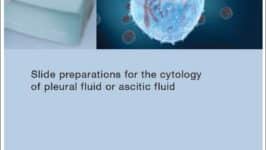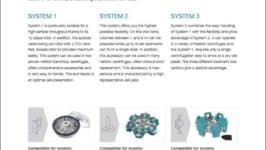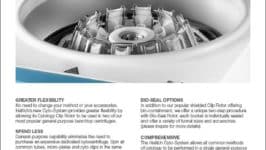Pleural or Ascitic Fluid Application Note
This application note provides information on specific application methods and the use of Hettich products. (more…) read more...
File size: 208.4 kb
In addition to mesothelial cells, pleural fluid and ascitic fluid also contain lymphocytes and eosinophilic and neutrophilic granulocytes. The protein content is frequently around 30 g/l. The cell content often varies considerably. Both fluids may contain blood, and ascitic fluid may also contain lipids.
Advantages of the Hettich Method
Preparation
1. Preparation of samples with an elevated erythrocyte content
Since a high erythrocyte content will have a negative effect on the quality of the preparation, it is recommended that the erythrocytes be removed using a lysis buffer before derivation of the cyto preparation.
a) Preparation of the lysis buffer
| 8.29 g | ammonium chloride (NH4Cl) |
| 1.0 g | potassium hydrogen carbonate (KHCO3) and |
| 0.037 g | ethylene-diamine-tetraacetic acid (EDTA) is made up to 1 liter with distilled water |
The lysis buffer should be autoclaved to extend its shelf life.
b) Lysis of the erythrocytes
• Centrifuge the sample fluid for 10 minutes at 350 x g (corresponding to 1,700 min-1 in the 6-place rotor and 1,900 min-1 in the 4-place rotor).
• Pipette off the supernatant and set it aside.
• Resuspend the sediment in lysis buffer (1 part by volume sediment to 10 parts by volume buffer).
• Mix well and allow to stand for 10 minutes at room temperature. The hemoglobin liberated results in a transparent red coloration.
• Stop the reaction by adding 10 x the volume of physiological saline (0.9% NaCl) or phosphate-buffered saline.
• Centrifuge at 350 x g for 10 minutes.
• Decant the supernatant containing the lysed erythrocytes and discard it.
• Resuspend the sediment in 10 ml 0.9% NaCl (or PBS), mix it thoroughly and centrifuge it again for 10 minutes at 350 x g.
• Discard the supernatant and resuspend the sediment in the original sample supernatant that was set aside, and mix it well. A cyto preparation can now be derived from the sample.
Important: Do not allow the cells to stand in the lysis buffer for too long as they may also be lysed.
2. Selection of suitable accessories
The 2 ml chamber (Cat. No. 1664) with sedimentation area of 60 mm2 and the 4 ml chamber (Cat. No. 1665) with sedimentation area of 120 mm2 are recommended for the centrifugation of pleural fluid and ascitic fluid. The 2 ml chamber is suitable for samples containing up to 100,000 cells and the 4 ml chamber for samples containing up to 200,000 cells.
3. Assembly of the cyto insert
Information on the assembly of the cyto insert is provided in our leaflet “Perfect preparations – with the Hettich cyto system all it takes is a turn”. For slide preparations from pleural fluid and ascitic fluid, it is generally necessary to use dry fixation. The cyto insert should, therefore, be assembled with the filter card (see B1 in the illustration). If the samples are infectious, then we recommend the use of our lid No. 1661 (see B2 in the diagram).
4. Centrifugation
a) Sedimentation
Fill the samples into the centrifugation tubes and centrifuge them for 10 minutes at 490 x g (corresponding to 2,000 min-1 with the 6-place rotor and 2,200 min-1 with the 4-place rotor).
b) Removal of the cell-free supernatant
The cell-free supernatant remains in the chamber after centrifugation and must be removed by careful aspiration.
It is crucial that the sediment is not disturbed while the supernatant is being removed, as this can affect the quality of the preparation and lead to cell loss. It is therefore recommended that the supernatant be removed using a Pasteur pipette with its tip just below the surface of the supernatant, moving downwards. The pipette should not come into contact with the slide – a small drop of liquid should be allowed to remain over the sediment!
c) Drying of the sediment
The sediment must be dried if the cells are to be stained using Giemsa stain. This requires a second centrifugation step. After removal of the supernatant, loosen the slide ring and remove it together with the chamber (see B4). Place the slide carrier with the slide and the filter card together with the suspension back in the centrifuge and centrifuge them for 1 minute at 1,100 x g (corresponding to 3,000 min-1 with the 6-place rotor and 3,400 min-1 with the 4-place rotor). The remaining liquid will be removed through centrifugal force and absorbed by the filter card. The cells will remain as a sediment on the slide. Their morphology will be intact and they will be well distributed over the surface. Evaporation artefacts such as leukocytes that are reduced in volume and the development of crystals will be avoided through the dry centrifugation.
d) Fixing and staining
The dry preparation can be fixed immediately and then stained.
Good to know: If Giemsa stain or May-Grünwald-Giemsa stain is used, then the slides must be rinsed with Weise or Sörensen buffer in a final step. They must then be dried. This can be achieved quickly and easily using the Labora System frame for six microscope slides (Cat. No. 1285):
Up to 36 slides can be dried at the same time in the 6-place rotor.
Hettich products are designed to help you achieve optimal results for your application and are built to perform to the specifications outlined in the operators manual. For application-specific information and settings, please refer to your organization’s standard operating procedure. As always, our Hettich representatives are here to help determine which Hettich products and accessories best fit your laboratory requirements.

This application note provides information on specific application methods and the use of Hettich products. (more…) read more...

This brochure provides information on the Hettich Cyto System rotors and accessories. (more…) read more...

This product sheet provides a detailed overview of the product features, benefits and models. (more…) read more...
Hettich manufactures centrifuges for any standard laboratory application.